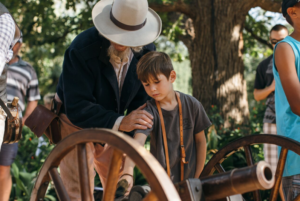
By Brittany Eck
This week, the Alamo welcomed the return of two historic cannons used during the 1836 Siege and Battle of the Alamo back to the Alamo grounds. The battle cannons revealed some surprising secrets during their conservation at the Texas A&M Conservation Research Lab in College Station, Texas. The cannons were sent to the lab in October as part of a larger effort to preserve all seven of the Alamo’s 1836 Battle Cannons and returned with several exciting new discoveries about their origins.
“In October, we shared our commitment to ensuring long-term, extensive preservation and conservation plans for the Alamo’s historic buildings and artifacts,” Texas General Land Office Commissioner George P. Bush said. “The 1836 Battle Cannons are among Texas’ most treasured artifacts, and we are ensuring they receive the care and honor they deserve. Fortunately, in doing this preservation work, we were able to discover more about the cannon’s history than we knew before. We can’t wait to share those exciting discoveries with all visitors and Texans.”
While at the Texas A&M Lab, the two cannons — known as the Rio Grande Cannon and the Spanish Cannon — underwent a thorough conservation process to ensure they remain in great shape on the Alamo grounds for generations to come. The process included electrolytic reduction to remove numerous layers of paint and corrosion products, followed by a series of boiling reverse-osmosis water baths to remove residual chemicals. After that, tannic acid and polyurethane sealant were applied to the cannons to make the iron corrosion-resistant and to form a water- and oxygen-resistant barrier.
“The Alamo cannons have been exposed to the elements for many years and were in need of a good cleaning and stabilization,” Lab Manager Jim Jobling said. “We were thrilled to be asked to be part of this special effort to preserve the 1836 Alamo Battle Cannons for future generations of Texans.”
Jobling’s team at the lab has cleaned and conserved thousands of artifacts during the past 39 years, and were hopeful they could uncover information about the cannons’ history during the preservation process. It didn’t take long. During the initial inspection, they were surprised to find an unfired cannonball loaded within the 4-pound Spanish cannon.
“This Spanish gun was more than 100 years old by the time it was used in the battle,” Jobling said, noting that the cannon was likely produced in the early 1700s. “While we can’t say for sure, it is possible that the cannonball we found in the gun was loaded during the 1836 Battle of the Alamo, but of course, never fired.”
The team removed various debris and two cannonballs from the muzzle and bore of the short, 6-pound cannon known as the Rio Grande cannon. They worked with cannon collectors and experts in Texas and England to determine that the cannon originated from the Bersham Foundry in Wrexham, Wales.
“When we received the cannon we noted that the ‘B’ engraved on the side might indicate it had come from the Bersham Foundry,” Jobling said. “Sure enough, our expert in England agreed. We believe this cannon was produced some time between 1770 and 1795.”
With the Rio Grande and Spanish cannons now back at the Alamo, two more cannons have been sent to the lab for preservation. The conservation work will continue until all seven of the Alamo’s battle cannons are treated and returned.
“It’s amazing that after 300 years, we’re still learning new things about the Alamo’s history and the 1836 siege and battle,” Alamo CEO Doug McDonald said. “Deepening our understanding of the Alamo’s history and sharing those discoveries with visitors is part of what makes working at the Alamo so rewarding. We know a lot of Alamo and history enthusiasts will be excited to learn more about these artifacts, and we can’t wait to see what we learn about the rest of our battle cannons.”
The Rio Grande and Spanish guns will soon be mounted permanently on the Alamo grounds for visitors to enjoy. An unveiling of their new location will be held on March 2, Texas Independence Day. All visitors and Texans are welcomed and encouraged to attend. For more information about preservation and restoration efforts ongoing at the Alamo, visit savethealamo.com.
